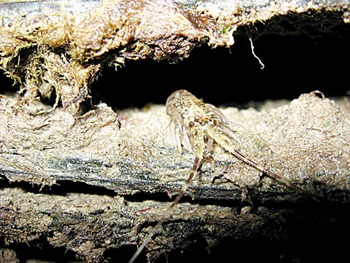By Karin Derkley

Monthly monitoring of Southern Rocklobster puerulus (late larval stage) settlement has been undertaken in Tasmania, Victoria and South Australia since the 1990s, but it is only recently that researchers have attempted to link settlement to future population assessments.
This process has been successfully used in Western Australia for several years to determine the levels at which adult rocklobsters can be fished, while maintaining the sustainability of the species.
However, South Australian Research and Development Institute (SARDI) research scientist Adrian Linnane says it appears the relationship between puerulus settlement and subsequent recruitment is less straightforward in the south-east.
He has co-authored a report on the subject in collaboration with scientists from Victoria and Tasmania.
“We’ve never been able to say that X number of puerulus will relate to Y number of legal-size rocklobsters down the track,” he says.
“What our report has shown is that you can say whether recruitment into the fishery is going to be low, average or high. More importantly, because we have now identified the time lag between settlement and recruitment, we can predict when pulses of recruitment will enter the fishery. This source of information is very important to both the industry and fishery managers.”
The findings form part of a tri-state study funded by the FRDC: ‘Sustainability of the rocklobster resource in south-eastern Australia in a changing environment: implications for assessment and management’.
The specific results on puerulus settlement are to be published later this year in the International Council for the Exploration of the Sea (ICES) Journal of Marine Science.
 Rocklobster puerulus sighted in a puerulus collector.
Rocklobster puerulus sighted in a puerulus collector. Photo: SARDI
The study showed broad spatial similarities in settlement patterns in SA and Victoria. However, the relationship with Tasmania is more complex, says Bridget Green, research scientist at the Institute for Marine and Antarctic Studies at the University of Tasmania, who led the Tasmanian leg of the study.
“The east coast of Tasmania, where we monitor our puerulus, is geographically distant from the south-eastern fishery, and its environmental conditions are completely different to those in western Victoria and SA, because the coast is subject to different currents,” she says.
Bridget Green says there is nevertheless still some relationship between the two fisheries, with the east coast getting about 10 per cent of its recruitment from SA, although this rate can vary from year to year depending on the strength of the westerly currents.
“In Tasmania, as in both SA and Victoria, we also monitor the undersized rocklobsters in the fishery to help predict future stock sizes,” she says.
Given that Tasmania’s west coast is subject to similar currents and environmental conditions to those experienced in SA and western Victoria, a correlation is more likely between puerulus settlement in SA and recruitment rates there.
However, with little monitoring of puerulus conducted in this remote region as yet, there is not enough data to confirm the correlation.
Establishing the link between puerulus settlement rates and recruitment is an important step for the industry, Adrian Linnane says.
“While we can’t give fishers an exact number, we can give them a good indicator of catch-rate levels in four to five years’ time based on the settlement rates we observe now. That’s a useful forecasting tool that we didn’t have before,” he says.
The strength of the relationship will become more apparent the longer the monitoring program continues.
“The longer the time series of data, the more confident we are as to what is going to happen.”
FRDC Research Code: 2009-047
More information
Adrian Linnane, 08 8207 5492
adrian.linnane@sa.gov.au





